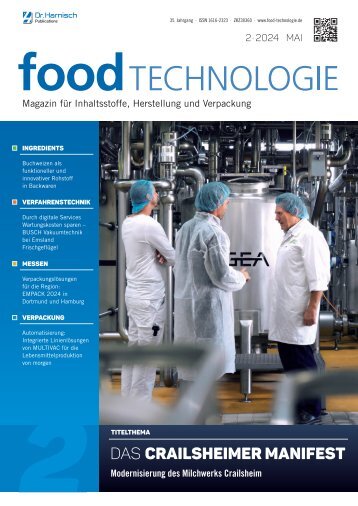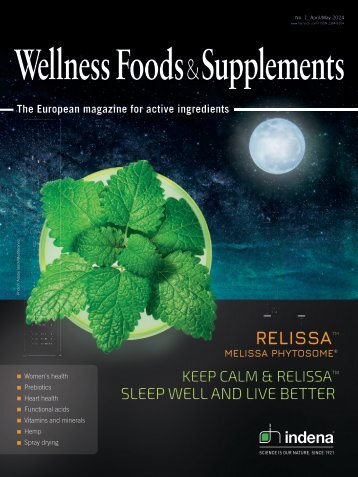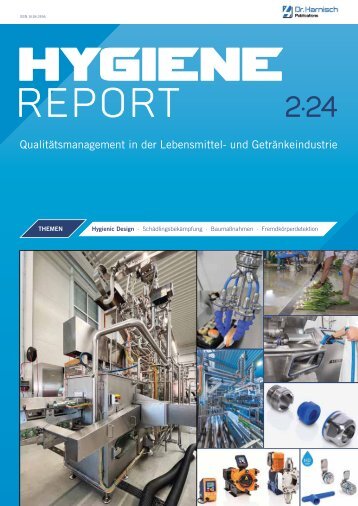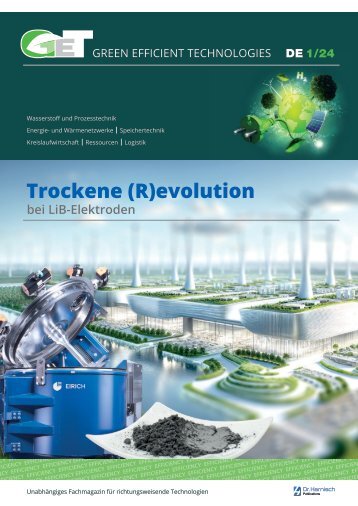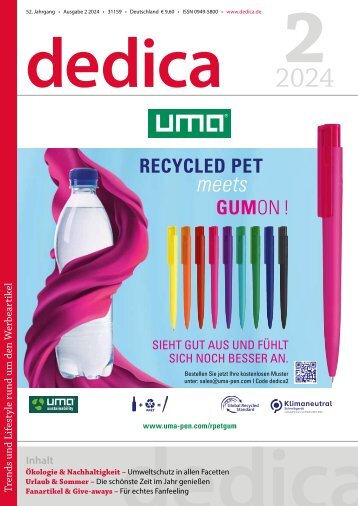GET – GREEN EFFICIENT TECHNOLOGIES EN 1/23
- Text
- Efficiency
- Hydrogen
- Pumps
- Technologies
- Efficient
- Solutions
- Materials
- Operating
- Sealing
- Applications
- Harnisch.com
Energy carrier hydrogen
Energy carrier hydrogen Transport Hydrogen transport - technologies and challenges Birka Friedrich • Large-scale import and export of green hydrogen is necessary for the energy transition and the global decarbonisation of industry. • There are various possible transport technologies for hydrogen - each with different advantages and disadvantages. • To build the global hydrogen economy in a timely manner and achieve the energy policy goals, all hydrogen transport technologies are equally needed. 1 3 2 Renewable energy sources such as solar, wind and hydropower are increasingly used worldwide due to their availability, cost efficiency and environmental friendliness. However, one of the challenges with these energy sources is their variability, i. e. they do not provide constant power generation. To solve this problem, scientists and engineers have been looking for ways to store and transport renewable energy for later use. One of the most promising solutions for that purpose are green molecules such as hydrogen. Hydrogen is a versatile, cleanly usable energy carrier that can be obtained from renewable sources such as solar and wind energy. When green hydrogen is burned, only water vapour and heat are produced. This makes it an emission-free fuel that can help reduce greenhouse gas emissions and combat climate change. However, what makes hydrogen particularly valuable for the renewable energy industry is its potential for storing and transporting energy over long distances and time spans. In addition, hydrogen can be used as a feedstock for industrial processes such as steel production, refineries or the chemical industry. For these reasons, many companies are currently looking for ways to convert their processes to hydrogen. 1. Hydrogen storage in our LOHC: Hydrogenation. The hydrogen molecules are chemically bound to the LOHC via a catalytic reaction in a continuous process. The hydrogenation is an exothermic process generating approx. 10 kWhth/kgH 2 heat at approx. 250 °C. 2. Hydrogen release from our LOHC: Dehydrogenation. The hydrogen molecules are chemically released from the LOHC via a catalytic reaction in a continuous process. The dehydrogenation is an endothermic process, that requires approx. 11 kWhth/kgH 2 heat at approx. 300 °C. The hydrogen can be released on-demand, assuring hydrogen-purity according to ISO-14687 in addition. 3. Hydrogen transportation in our LOHC. Easy and cost-efficient logistics utilizing the existing infrastructure for fossil fuels via ship, barge, train or truck. Same applies to LOHC stocking facilities. Currently, heavy industry mainly uses hydrogen from natural gas and crude oil. With green hydrogen from renewable energies these industries can reduce their carbon footprint and contribute to a more sustainable development. To meet the overall demand for affordable green hydrogen in industrialised countries like Germany, large-volume imports from very sun- and wind-rich regions will become part of the supply. What transport technologies are available and what are the differences, advantages and disadvantages? There are various ways of transporting hydrogen, which have their specific advantages and disadvantages depending on the application. Some of the most common, non-pipeline hydrogen transport technologies are presented below: Compressed hydrogen Compressed hydrogen is the simplest and most widely used form of hydrogen transport. Here, the hydrogen gas is compressed to a high pressure (usually between 350 and 700 bar) and stored in high-pressure tanks. The advantage of this method is its simplicity and its applicability on a small scale, e. g. in fuel cell vehicles and emergency power systems. However, compressed hydrogen has a low energy density, so large tanks are required and it is not suitable for long-distance transport or large-scale storage. 14 GREEN EFFICIENT TECHNOLOGIES 2023
Energy carrier hydrogen Transport Liquefied hydrogen Liquefied hydrogen is another common method of hydrogen transport. In this technique, the hydrogen gas is cooled to a very low temperature (-253 °C) and condensed into a liquid aggregate state, which is then stored in cryogenic tanks. The advantage of this method is that it requires no further conversion processes - the hydrogen can be used directly at its destination. It also enables a higher energy density compared to compressed hydrogen, which makes it interesting for storing large amounts of energy. However, liquefied hydrogen requires a complex and expensive infrastructure for handling and storage. Cooling down is very energy-intensive, and large-scale application of this technology still needs to be explored. For example, there is currently only one tank ship suitable for long-distance transport of liquefied hydrogen, the Suiso Frontier. Another disadvantage of large-scale application is the hydrogen losses in the form of boil-off effects (evaporation of the hydrogen). Hydrogen converted to ammonia Hydrogen can also be converted into ammonia, which is a widely traded feedstock for fertiliser production with an established infrastructure for storage and transport. Ammonia has a higher energy density than, for example, compressed hydrogen and is therefore discussed not only as a feedstock but also as a transport medium for hydrogen. The advantage of ammonia is its wide availability. However, the process of converting hydrogen into ammonia is energy-intensive, and the recovery of hydrogen on an industrial scale has yet to be researched. There is also the question of safety - ammonia is very toxic and corrosive, which makes it very difficult to handle, for example in urban environments and ports. Hydrogen bonded to liquid organic hydrogen carriers (LOHC) Hydrogen can be stored in Liquid Organic Hydrogen Carriers (LOHC). These are organic compounds that can absorb hydrogen in a chemical, catalytic process called hydrogenation and release it again in a chemical process called dehydrogenation. Instead of transporting the hydrogen in molecular form, it is bound to the LOHC, which is then transported to the customer by tanker truck, train, tanker ship or barge. There, the hydrogen is released from the LOHC again and can be used. There are several possible LOHCs, such as carbazole, toluene/methylcyclohexane, dibenzyltoluene or benzyltoluene. The latter has particularly positive properties as a hydrogen carrier, as it is a non-explosive, flame-retardant thermal oil with a comparable hazard potential to diesel. In contrast to other hydrogen transport methods, LOHCs based on benzyltoluene (LOHC-BT) can be stored under ambient temperature and transported over long distances in the existing liquid fuel infrastructure. There are no hydrogen losses (e. g. “boil-off”) even over long periods of time. After the hydrogen is released from the LOHC, the carrier material is not consumed, but transported back to the site of hydrogen production and reused several hundred times for hydrogen transport. By leveraging existing infrastructure, LOHC-BT is particularly quick and inexpensive to implement, and the flexibility of the technology favours diversification of import routes. While hydrogenation is an exothermic, catalytic process and generates excess heat energy, dehydrogenation is an endothermic, catalytic process - it requires additional energy in the form of heat. This opens up synergies on the hydrogen production side, where the excess heat from hydrogenation can be fed into local heat grids or used for seawater desalination, for example. On the offtake side, heavy industry with a lot of process heat (e.g. steel mills) could use their surplus heat to dehydrogenate the hydrogen from the LOHC-BT. Gaseous hydrogen transported via pipes/pipelines Transporting hydrogen by pipeline is another option, especially for countries with an existing natural gas pipeline infrastructure. Gaseous hydrogen can be transported under high pressure, which allows efficient transport over long distances. In some cases, hydrogen can even be mixed with natural gas and transported in the same pipelines, although this requires careful monitoring to ensure safe operation. One advantage of pipeline transport is that it is already a mature technology, as many countries have extensive pipeline networks for natural gas distribution. However, retrofitting existing pipelines for hydrogen transport may require significant investments, especially with regard to safety measures. Moreover, the availability of compressors suitable for large-scale hydrogen transport is still being researched, and connecting new consumers is not always possible. Another challenge is that hydrogen can embrittle some pipeline materials, especially those made of certain types of steel. This means that pipelines for hydrogen transport may have to be made of other materials or have additional coatings to prevent corrosion. COG MAKES ITS MARK: With products from COG – the future is now. Tested materials for reliable application in hydrogen technology. www.COG.de/en
- Seite 1 und 2: GREEN EFFICIENT TECHNOLOGIES EN 1/2
- Seite 3 und 4: Editorial Harvest the sun Humanity
- Seite 5 und 6: HAMPRO® HIGH-PRESSURE PROCESS TECH
- Seite 7 und 8: Leading article sion. In fact, it i
- Seite 9 und 10: Cover story Efficiency Class IE2 IE
- Seite 11 und 12: Cover story Myth 3: Journal bearing
- Seite 13: Cover story Sealless pumps, both ce
- Seite 17 und 18: Energy carrier hydrogen Material se
- Seite 19 und 20: Energy carrier hydrogen Material se
- Seite 21 und 22: Energy efficiency Heat recovery Fig
- Seite 23 und 24: Energy efficiency Heat recovery Fig
- Seite 25 und 26: From the research Heat pumps Fig. 2
- Seite 27 und 28: From the research Heat pumps Fig. 6
- Seite 29 und 30: Efficient manufacturing Special mec
- Seite 31 und 32: Decarbonisation Supply traffic Fig.
- Seite 33 und 34: Decarbonisation Supply traffic shou
- Seite 35 und 36: Decarbonisation Operating power max
- Seite 37 und 38: Decarbonisation Operating power pro
- Seite 39 und 40: Decarbonisation Production local su
- Seite 41 und 42: Decarbonisation Production fast swi
- Seite 43 und 44: Circular economy Production deep) o
- Seite 45 und 46: PROCESS TECHNOLOGY&COMPONENTS © Ae
- Seite 47 und 48: Companies - Innovations - Products
- Seite 49 und 50: Companies - Innovations - Products
- Seite 51 und 52: Brand name register Lutz Pumpen Gmb
- Seite 54: Dr. Harnisch Verlags GmbH Eschenstr
Unangemessen
Laden...
Magazin per E-Mail verschicken
Laden...
Einbetten
Laden...








































